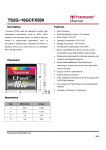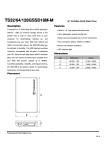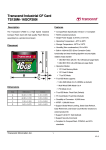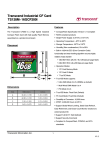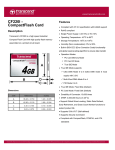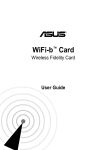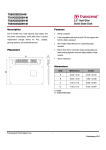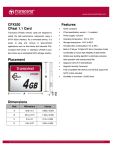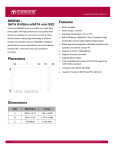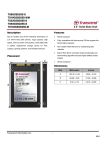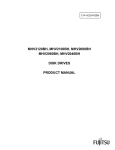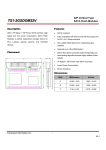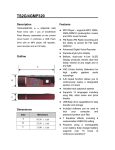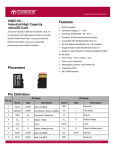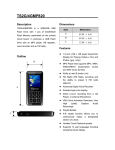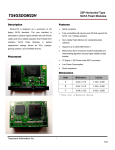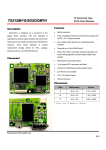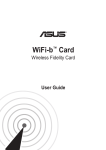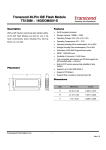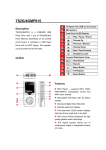Download Transcend TS32GMSA300 solid state drive
Transcript
TS2G~16GMSA500 TS16G~64GMSA300 mSATA SSD Features Description The Transcend TSxGMSA500/TSxGMSA300 is a • RoHS compliant series of mSATA SSD device with high performance and • Power Supply: 3.3V±5% quality Flash Memory assembled on a printed circuit • Operating Temperature: 0oC to 70oC board. These devices feature cutting-edge technique to • Storage Temperature: -40oC to 85oC enhance product life and data retention. By using these • Humidity (Non condensation): 0% to 95% techniques, the product is designed especially for some • TSxGMSA500 Built-in 8-bit/512Byte ECC (Error tough applications, like industrial PC, vehicle PC and Correction Code) functionality ensures highly reliable of road surveillance record. data transfer. • TSxGMSA300 Built-in 15-bit/512Byte ECC (Error Correction Code) functionality ensures highly reliable of Placement data transfer. • Global wear-leveling algorithm eliminates excessive write operation and extends product life. • Support StaticDataRefresh & EarlyRetirement technology to monitor error bit level and react before data is corrupted. • Support S.M.A.R.T (Self-defined) • Support Security Command • Fully compatible with devices and OS that support the SATA 3Gb/s standard • Non-volatile SLC/MLC Flash Memory for outstanding data retention Dimensions Transcend Information Inc. Side Millimeters Inches W 29.85 1.175 L 50.80 2.000 H 3.5 0.137 1 V1.0 TS2G~16GMSA500 TS16G~64GMSA300 mSATA SSD Specifications Physical Specification Form Factor MO-300 Storage Capacities 2GB~64GB Dimensions (mm) Length 50.8 ± 0.15 Width 29.85 ± 0.15 Height 3.5 ± 0.1 Input Voltage 3.3V ± 5% Weight 9g Connector PCI Express Mini Card Connector Environmental Specifications Operating Temperature 0 ℃ to 70 ℃ Storage Temperature -40 ℃ to 85 ℃ Humidity Operating 0% to 95% (Non-condensing) Non-Operating 0% to 95% (Non-condensing) Regulations Compliance CE, FCC and BSMI Performance Model P/N Read Write Random Read Random Write TS2GMSA500 56 MB/s 27 MB/s 50 MB/s 8 MB/s TS4GMSA500 56 MB/s 49 MB/s 50 MB/s 12 MB/s TS8GMSA500 102 MB/s 88 MB/s 83 MB/s 17 MB/s TS16GMSA500 108 MB/s 91 MB/s 89 MB/s 18 MB/s Model P/N Read Write Random Read Random Write TS16GMSA300 101 MB/s 17 MB/s 55 MB/s 5 MB/s TS32GMSA300 99 MB/s 35 MB/s 60 MB/s 8 MB/s TS64GMSA300 96 MB/s 38 MB/s 59 MB/s 9 MB/s Performance ® Note:25 ℃, test on ASUS P4S800-MX, 1GB RAM, Windows XP Version 2002 SP2, benchmark utility HDBENCH (version Transcend Information Inc. 2 V1.0 TS2G~16GMSA500 TS16G~64GMSA300 mSATA SSD 3.4006), copied file 1GB Actual Capacity Model P/N User Max. LBA Cylinder Head Sector TS2GMSA500 3,865,680 3,835 16 63 TS4GMSA500 7,732,368 7,671 16 63 TS8GMSA500 15,465,344 15,343 16 63 TS16GMSA500 30,932,992 16,383 15 63 TS16GMSA300 30,932,992 16,383 15 63 TS32GMSA300 61,865,984 16.383 15 63 TS64GMSA300 123,731,968 16,383 15 63 Power Requirements Input Voltage 3.3V ± 5% Mode Power Consumption Max. (mA) Write(peak) 352 Read(peak) 371 Idle(peak) 141 SHOCK & Vibration Test Condition Mechanical Shock Test Vibration Test Transcend Information Inc. Standard 1500G, 0.5ms, 3 axes IEC 60068-2-27 20G (Peak-to-Peak) 20Hz to 2000Hz (Frequency) IEC 60068-2-6 3 V1.0 TS2G~16GMSA500 TS16G~64GMSA300 mSATA SSD Package Dimensions Below figure illustrates the Transcend mSATA Solid State Disk product. All dimensions are in mm. Transcend Information Inc. 4 V1.0 TS2G~16GMSA500 TS16G~64GMSA300 mSATA SSD Pin Assignments Pin No. Pin Name Pin No. Pin Name 01 NC 02 3.3V 03 NC 04 GND 05 NC 06 NC 07 NC 08 NC 09 GND 10 NC 11 NC 12 NC 13 NC 14 NC 15 GND 16 NC 17 NC 18 GND 19 NC 20 NC 21 GND 22 NC 23 TX+ 24 3.3V 25 TX- 26 GND 27 GND 28 NC 29 GND 30 NC 31 RX- 32 GND 33 RX+ 34 GND 35 GND 36 NC 37 GND 38 NC 39 3.3V 40 GND 41 3.3V 42 NC 43 GND 44 NC 45 NC 46 NC 47 NC 48 NC 49 NC 50 GND 51 Presence Detection 52 3.3V Pin Layout Transcend Information Inc. 5 V1.0 TS2G~16GMSA500 TS16G~64GMSA300 mSATA SSD Block Diagram mSATA Interface SATA Flash CTL Flash Transcend Information Inc. Flash Flash Flash 6 V1.0 TS2G~16GMSA500 TS16G~64GMSA300 mSATA SSD Reliability Wear-Leveling algorithm The controller supports static/dynamic wear leveling. When the host writes data, the controller will find and use the block with the lowest erase count among the free blocks. This is known as dynamic wear leveling. When the free blocks' erase count is higher than a threshold value plus data blocks', it will activate the static wear leveling, replacing the not so frequently used user blocks with the high erase count free blocks. ECC algorithm Using 15bit BCH Error Correction Code with each channel, the controller can correct 15 random bits per 512 byte data sector for MLC NAND flash. The hardware executes parity generation and error detection/correction features. StaticDataRefresh Technology Normally, ECC engine corrections are taken place without affecting the host normal operations. As time passes by, the number of error bits accumulated in the read transaction exceeds the correcting capability of the ECC engine, resulting in corrupted data being sent to the host. To prevent this, the controller monitors the error bit levels at each read operation; when it reaches the preset threshold value, the controller automatically performs data refresh to “restore” the correct charge levels in the cell. This implementation practically restores the data to its original, error-free state, and hence, lengthening the life of the data. EarlyRetirement Technology The StaticDataRefresh feature functions well when the cells in a block are still healthy. As the block ages over time, it cannot reliably store charge anymore and EarlyRetirement enters the scene. EarlyRetirement works by moving the static data to another block (a health block) before the previously used block becomes completely incapable of holding charges for data. When the charge loss error level exceeds another threshold value (higher from that for StaticDataRefresh), the controller automatically moves its data to another block. In addition, the original block is then marked as a bad block, which prevents its further use, and thus the block enters the state of “EarlyRetirement.” Note that, through this process, the incorrect data are detected and effectively corrected by the ECC engine, thus the data in the new block is stored error-free. Transcend Information Inc. 7 V1.0 TS2G~16GMSA500 TS16G~64GMSA300 mSATA SSD mSATA Interface Out of bank signaling There shall be three Out Of Band (OOB) signals used/detected by the Phy: COMRESET, COMINIT, and COMWAKE. COMINIT, COMRESET and COMWAKE OOB signaling shall be achieved by transmission of either a burst of four Gen1 ALIGNP primitives or a burst composed of four Gen1 Dwords with each Dword composed of four D24.3 characters, each burst having a duration of 160 UIOOB. Each burst is followed by idle periods (at common-mode levels), having durations as depicted in Figure 4 and Table 2. Figure 4: OOB signals Table 2: OOB signal times Transcend Information Inc. 8 V1.0 TS2G~16GMSA500 TS16G~64GMSA300 mSATA SSD COMRESET COMRESET always originates from the host controller, and forces a hardware reset in the device. It is indicated that transmitting bursts of data separated by an idle bus condition. The OOB COMRESET signal shall consist of no less than six data bursts, including inter-burst temporal spacing. The COMRESET signal shall be: 1) Sustained/continued uninterrupted as long as the system hard reset is asserted, or 2) Started during the system hardware reset and ended some time after the negation of system hardware reset, or 3) Transmitted immediately following the negation of the system hardware reset signal. The host controller shall ignore any signal received from the device from the assertion of the hardware-reset signal until the COMRESET signal is transmitted. Each burst shall be 160 Gen1 UI’s long (106.7 ns) and each inter-burst idle state shall be 480 Gen1 UI’s long (320 ns). A COMRESET detector looks for four consecutive bursts with 320 ns spacing (nominal). Any spacing less than 175 ns or greater than 525 ns, it shall invalidate the COMRESET detector output. The COMRESET interface signal to the Phy layer shall initiate the Reset sequence shown in Figure 5 below. The interface shall be held inactive for at least 525 ns after the last burst to ensure far-end detector detects the negation properly. Figure 5: Comreset sequence Transcend Information Inc. 9 V1.0 TS2G~16GMSA500 TS16G~64GMSA300 mSATA SSD Description: 1. Host/device is powered and operating normally with some form of active communication. 2. Some condition in the host causes the host to issue COMRESET 3. Host releases COMRESET. Once the condition causing the COMRESET is released, the host releases the COMRESET signal and puts the bus in a quiescent condition. 4. Device issues COMINIT – When the device detects the release of COMRESET, it responds with a COMINIT. This is also the entry point if the device is late starting. The device may initiate communications at any time by issuing a COMINIT. 5. Host calibrates and issues a COMWAKE. 6. Device responds – The device detects the COMWAKE sequence on its RX pair and calibrates its transmitter (optional). Following calibration the device sends a six burst COMWAKE sequence and then sends a continuous stream of the ALIGN sequence starting at the device's highest supported speed. After ALIGNP Dwords have been sent for 54.6us (2048 nominal Gen1 Dword times) without a response from the host as determined by detection of ALIGNP primitives received from the host, the device assumes that the host cannot communicate at that speed. If additional speeds are available the device tries the next lower supported speed by sending ALIGNP Dwords at that rate for 54.6 us (2048 nominal Gen1 Dword times.) This step is repeated for as many slower speeds as are supported. Once the lowest speed has been reached without response from the host, the device enters an error state. 7. Host locks – after detecting the COMWAKE, the host starts transmitting D10.2 characters at its lowest supported rate. Meanwhile, the host receiver locks to the ALIGN sequence and, when ready, returns the ALIGN sequence to the device at the same speed as received. A host shall be designed such that it acquires lock in 54.6us (2048 nominal Gen1 Dword times) at any given speed. The host should allow for at least 873.8 us (32768 nominal Gen1 Dword times) after detecting the release of COMWAKE to receive the first ALIGNP. This ensures interoperability with multi-generational and synchronous designs. If no ALIGNP is received within 873.8 us (32768 nominal Gen1 Dword times) the host restarts the power-on sequence – repeating indefinitely until told to stop by the Application layer. 8. Device locks – the device locks to the ALIGN sequence and, when ready, sends SYNCP indicating it is ready to start normal operation. 9. Upon receipt of three back-to-back non-ALIGNP primitives, the communication link is established and normal operation may begin. Transcend Information Inc. 10 V1.0 TS2G~16GMSA500 TS16G~64GMSA300 mSATA SSD COMINIT COMINIT always originates from the drive and requests a communication initialization. It is electrically identical to the COMRESET signal except that it originates from the device and is sent to the host. The device uses it to request a reset from the host in accordance to the sequence shown in Figure 6, below. Figure 6: cominit sequence Description: 1. Host/device are powered and operating normally with some form of active communication. 2. Some condition in the device causes the device to issues a COMINIT 3. Host calibrates and issues a COMWAKE. 4. Device responds – The device detects the COMWAKE sequence on its RX pair and calibrates its transmitter (optional). Following calibration the device sends a six burst COMWAKE sequence and then sends a continuous stream of the ALIGN sequence starting at the device's highest supported speed. After ALIGNP Dwords have been sent for 54.6 us (2048 nominal Gen1 Dword times) without a response from the host as determined by detection of ALIGNP primitives received from the host, the device assumes that the host cannot communicate at that speed. If additional speeds are available, the device tries the next lower supported speed by sending ALIGNP Dwords at that rate for 54.6 us (2048 nominal Gen1 Dword Transcend Information Inc. 11 V1.0 TS2G~16GMSA500 TS16G~64GMSA300 mSATA SSD times.) This step is repeated for as many slower speeds as are supported. Once the lowest speed has been reached without response from the host, the device enters an error state. 5. Host locks – after detecting the COMWAKE, the host starts transmitting D10.2 characters at its lowest supported rate. Meanwhile, the host receiver locks to the ALIGN sequence and, when ready, returns the ALIGN sequence to the device at the same speed as received. A host shall be designed such that it acquires lock in 54.6 us (2048 nominal Gen1 Dword times) at any given speed. The host should allow for at least 873.8 us (32768 nominal Gen1 Dword times) after detecting the release of COMWAKE to receive the first ALIGNP. This ensures interoperability with multi-generational and synchronous designs. If no ALIGNP is received within 873.8 us (32768 nominal Gen1 Dword times) the host restarts the power-on sequence – repeating indefinitely until told to stop by the Application layer. 6. Device locks – the device locks to the ALIGN sequence and, when ready, sends SYNCP indicating it is ready to start normal operation. 6. Upon receipt of three back-to-back non-ALIGNP primitives, the communication link is established and normal operation may begin. Power on sequence timing diagram The following timing diagrams and descriptions are provided for clarity and are informative. The state diagrams provided in section 8.4 comprise the normative behavior specification and is the ultimate reference. Figure 7: power on sequence Transcend Information Inc. 12 V1.0 TS2G~16GMSA500 TS16G~64GMSA300 mSATA SSD Description: 1. Host/device power-off - Host and device power-off. 2. Power is applied - Host side signal conditioning pulls TX and RX pairs to neutral state (common mode voltage). 3. Host issues COMRESET 4. Host releases COMRESET. Once the power-on reset is released, the host releases the COMRESET signal and puts the bus in a quiescent condition. 5. Device issues COMINIT – When the device detects the release of COMRESET, it responds with a COMINIT. This is also the entry point if the device is late starting. The device may initiate communications at any time by issuing a COMINIT. 6. Host calibrates and issues a COMWAKE. 7. Device responds – The device detects the COMWAKE sequence on its RX pair and calibrates its transmitter (optional). Following calibration the device sends a six burst COMWAKE sequence and then sends a continuous stream of the ALIGN sequence starting at the device's highest supported speed. After ALIGNP primitives have been sent for 54.6 us (2048 nominal Gen1 Dword times) without a response from the host as determined by detection of ALIGNP primitives received from the host, the device assumes that the host cannot communicate at that speed. If additional speeds are available the device tries the next lower supported speed by sending ALIGNP primitives at that rate for 54.6 us (2048 nominal Gen1 Dword times.) This step is repeated for as many slower speeds as are supported. Once the lowest speed has been reached without response from the host, the device shall enter an error state. 8. Host locks – after detecting the COMWAKE, the host starts transmitting D10.2 characters at its lowest supported rate. Meanwhile, the host receiver locks to the ALIGN sequence and, when ready, returns the ALIGN sequence to the device at the same speed as received. A host shall be designed such that it acquires lock in 54.6 us (2048 nominal Gen1 Dword times) at any given speed. The host should allow for at least 873.8 us (32768 nominal Gen1 Dword times) after detecting the release of COMWAKE to receive the first ALIGNP. This insures interoperability with multi-generational and synchronous designs. If no ALIGNP is received within 873.8 us (32768 nominal Gen1 Dword times) the host restarts the power-on sequence – repeating indefinitely until told to stop by the Application layer. 9. Device locks – the device locks to the ALIGN sequence and, when ready, sends the SYNCP primitive indicating it is ready to start normal operation. 10. Upon receipt of three back-to-back non-ALIGNP primitives, the communication link is established and normal operation may begin. Transcend Information Inc. 13 V1.0 TS2G~16GMSA500 TS16G~64GMSA300 mSATA SSD ATA command register This table with the following paragraphs summarizes the ATA command set. Support ATA/ATAPI Command Code Protocol EXECUTE DIAGNOSTICS 90h Device diagnostic FLUSH CACHE E7h Non-data IDENTIFY DEVICE ECh PIO data-In READ DMA C8h DMA READ MULTIPLE C4h PIO data-In 20h PIO data-In General Feature Set READ SECTOR(S) READ VERIFY SECTOR(S) 40h or 41h Non-data EFh Non-data SET MULTIPLE MODE C6h Non-data WRITE DMA CAh DMA WRITE MULTIPLE C5h PIO data-out WRITE SECTOR(S) 30h PIO data-out NOP 00h Non-data READ BUFFER E4h PIO data-In WRITE BUFFER E8h PIO data-out SET FEATURES Power Management Feature Set CHECK POWER MODE E5h or 98h Non-data IDLE E3h or 97h Non-data IDLE IMMEDIATE E1h or 95h Non-data SLEEP E6h or 99h Non-data STANDBY E2h or 96h Non-data STANDBY IMMEDIATE E0h or 94h Non-data Security Mode Feature Set SECURITY SET PASSWORD F1h PIO data-out SECURITY UNLOCK F2h PIO data-out SECURITY ERASE PREPARE F3h Non-data SECURITY ERASE UNIT F4h PIO data-out SECURITY FREEZE LOCK F5h Non-data SECURITY DISABLE PASSWORD F6h PIO data-out SMART Disable Operations B0h Non-data SMART Enable/Disable Autosave B0h Non-data SMART Enable Operations B0h Non-data SMART Feature Set SMART Return Status B0h Non-data SMART Execute Off-Line Immediate B0h Non-data SMART Read Data B0h PIO data-In Read Native Max Address F8h Non-data Set Max Address F9h Non-data Set Max Set Password F9h PIO data-out Set Max Lock F9h Non-data Set Max Freeze Lock F9h Non-data Set Max Unlock F9h PIO data-out Host Protected Area Feature Set Transcend Information Inc. 14 V1.0 TS2G~16GMSA500 TS16G~64GMSA300 mSATA SSD ATA Command Command Specifications FLUSH CACHE (E7h) The host uses this command to request the device to flush the write cache. If there is data in the write cache, that data shall be written to the media. The BSY bit shall remain set to one until all data has been successfully written or an error occurs. IDENTIFY DEVICE (ECh) This commands read out 512Bytes of drive parameter information. Parameter Information consists of the arrangement and value as shown in the following table. This command enables the host to receive the Identify Drive Information from the device. Identify Device Information Default Value Word Address Default Value Total Bytes 0 044Ah 2 General configuration 1 XXXXh 2 Default number of cylinders 2 0000h 2 Reserved 3 00XXh 2 Default number of heads 4 0000h 2 Obsolete 5 0240h 2 Obsolete 6 XXXXh 2 Default number of sectors per track 7-8 XXXXh 4 Number of sectors per card (Word 7 = MSW, Word 8 = LSW) 9 0000h 2 Obsolete 10-19 aaaa 20 Serial number in ASCII (Right Justified) 20 0002h 2 Obsolete 21 0002h 2 Obsolete 22 0004h 2 Obsolete 23-26 aaaa 8 Firmware revision in ASCII. Big Endian Byte Order in Word 27-46 aaaa 40 Model number in ASCII (Left Justified) Big Endian Byte Order in Word 47 8001h 2 Maximum number of sectors on Read/Write Multiple command Transcend Information Inc. Data Field Type Information 15 V1.0 TS2G~16GMSA500 TS16G~64GMSA300 mSATA SSD Identify Device Information Default Value Word Address Default Value Total Bytes 48 0000h 2 Reserved 49 0F00h 2 Capabilities 50 4000h 2 Capabilities Data Field Type Information 51 0200h 2 PIO data transfer cycle timing mode 52 0000h 2 Obsolete 53 0007h 2 Field Validity 54 XXXXh 2 Current numbers of cylinders 55 00XXh 2 Current numbers of heads 56 XXXXh 2 Current sectors per track 57-58 XXXXh 4 Current capacity in sectors (LBAs)(Word 57 = LSW, Word 58 = MSW) 59 01XXh 2 Multiple sector setting 60-61 XXXXh 4 Total number of sectors addressable in LBA Mode 62 0000h 2 Reserved 63 0007h 2 Multiword DMA transfer. Supports MDMA Mode 0,1,and 2 64 0003h 2 Advanced PIO modes supported 65 0078h 2 Minimum Multiword DMA transfer cycle time per word. In PC Card modes this value shall be 0h 66 0078h 2 Recommended Multiword DMA transfer cycle time. In PC Card modes this value shall be 0h 67 0078h 2 Minimum PIO transfer cycle time without flow control 68 0078h 2 Minimum PIO transfer cycle time with IORDY flow control 69-75 0000h 14 76 0006h 2 Reserved Serial ATA capacities .Support Serial ATA Gen1 .Support Serial ATA Gen2 77-79 000h 6 Reserved 80 0080h 2 Minor version number (ATAPI-7) 81 0000h 2 Minor version number 82 742Bh 2 Command sets supported 0 83 550Ch 2 Command sets supported 1 84 4002h 2 Command sets supported 2 85-87 XXXXh 6 Features/command sets enabled 88 047Fh 2 Ultra DMA Mode Supported and Selected 89 0001h 2 Time required for Security erase unit completion 90 0000h 2 Time required for Enhanced security erase unit completion 91 0000h 2 Current Advanced power management value 92 FFFEh 2 Master Password Revision Code Transcend Information Inc. 16 V1.0 TS2G~16GMSA500 TS16G~64GMSA300 mSATA SSD Identify Device Information Default Value Word Address Default Value Total Bytes 93-127 0000h 70 Reserved 128 0001h 2 Security status 129-159 0000h 64 Vendor unique bytes 160 81F4h 2 Power requirement description 161 0000h 2 Reserved 162 0000h 2 Key management schemes supported 163 0000h 2 CF Advanced True IDE Timing Mode Capability and Setting 164 0000h 2 Reserved 165-175 0000h 22 Reserved 176-255 0000h 140 Reserved Data Field Type Information READ DMA (C8h) Read data from sectors during Ultra DMA and Multiword DMA transfer. Use the SET FEATURES command to specify the mode value. A sector count of zero requests 256 sectors. READ MULTIPLE (C4h) This command performs similarly to the Read Sectors command. Interrupts are not generated on each sector, but on the transfer of a block, which contains the number of sectors defined by a Set Multiple command. READ SECTOR(S) (20h) This command reads 1 to 256 sectors as specified in the Sector Count register from sectors that is set by Sector number register. A sector count of 0 requests 256 sectors. The transfer beings specified in the Sector Number register. READ VERIFY SECTOR(S) (40h/41h) This command verifies one or more sectors on the drive by transferring data from the flash media to the data buffer in the drive and verifying that the ECC is correct. This command is identical to the Read Sectors command, except that DRQ is never set and no data is transferred to the host. SET FEATURES (EFh) This command set parameter to Features register and set drive’s operation. For transfer mode, parameter is set to Sector Count register. The host to establish or select certain features uses this command. SET MULTIPLE MODE (C6h) This command enables the device to perform READ MULTIPLE and WRITE MULTIPLE operations and establishes the block count for these commands. WRITE DMA (CAh) Write data to sectors during Ultra DMA and Multiword DMA transfer. Use the SET FEATURES command to specify the mode value. WRITE MULTIPLE (C5h) This command is similar to the Write Sectors command. Interrupts are not presented on each sector, but on the Transcend Information Inc. 17 V1.0 TS2G~16GMSA500 TS16G~64GMSA300 mSATA SSD transfer of a block, which contains the number of sectors defined by Set Multiple command. WRITE SECTOR(S) (30h) Write data to a specified number of sectors (1 to 256, as specified with the Sector Count register) from the specified address. Specify “00h” to write 256 sectors. NOP (00h) The device shall respond with command aborted. For devices implementing the Overlapped feature set, subcommand code 00h in the Features register shall abort any outstanding queue. Subcommand codes 01h through FFh in the Features register shall not affect the status of any outstanding queue. READ BUFFER (E4h) The READ BUFFER command enables the host to read a 512-byte block of data. WRITE BUFFER (E8h) This command enables the host to write the contents of one 512-byte block of data to the device’s buffer. Power Management Feature Set CHECK POWER MODE (E5h or 98h) The host can use this command to determine the current power management mode. IDLE (E3h or 97h) This command causes the device to set BSY, enter the “Idle” mode, clear BSY and generate an interrupt. If sector count is non-zero, the automatic power down mode is enabled. If the sector count is zero, the automatic power mode is disabled. IDLE IMMEDIATE (E1h or 95h) This command causes the device to set BSY, enter the “Idle”(Read) mode, clear BSY and generate an interrupt. SLEEP (E6h or 99h) This command causes the device to set BSY, enter the Sleep mode, clear BSY and generate an interrupt. STANDBY (E2h or 96h) This command causes the device to set BSY, enter the Sleep mode (which corresponds to the ATA “Standby” Mode), clear BSY and return the interrupt immediately. STANDBY IMMEDIATE (E0h or 94h) This command causes the drive to set BSY, enter the Sleep mode (which corresponds to the ATA “Standby” Mode), clear BSY and return the interrupt immediately. Transcend Information Inc. 18 V1.0 TS2G~16GMSA500 TS16G~64GMSA300 mSATA SSD Security Mode Feature Set SECURITY SET PASSWORD (F1h) This command set user password or master password. The host outputs sector data with PIO data-out protocol to indicate the information defined in the following table. Security set Password data content Word 0 Content Control word Bit 0 Identifier 0=set user password 1=set master password Bits 1-7 Reserved Bit 8 Security level 0=High 1=Maximum Bits 9-15 1-16 17-255 Reserved Password (32 bytes) Reserved SECURITY UNLOCK (F2h) This command disables LOCKED MODE of the device. This command transfers 512 bytes of data from the host with PIO data-out protocol. The following table defines the content of this information. Security Unlock information Word 0 Content Control word Bit 0 Identifier 0=compare user password 1=compare master password Bits 1-15 1-16 17-255 Reserved Password (32 bytes) Reserved SECURITY DISABLE PASSWORD (F6h) Disables any previously set user password and cancels the lock. The host transfers 512 bytes of data, as shown in the following table, to the drive. The transferred data contains a user or master password, which the drive compares with the saved password. If they match, the drive cancels the lock. The master password is still saved. It is re-enabled by issuing the SECURITY SET PASSWORD command to re-set a user password. SECURITY ERASE PREPARE (F3h) Transcend Information Inc. 19 V1.0 TS2G~16GMSA500 TS16G~64GMSA300 mSATA SSD This command shall be issued immediately before the Security Erase Unit command to enable erasing and unlocking. This command prevents accidental loss of data on the drive. SECURITY ERASE UNIT (F4h) The host uses this command to transfer 512 bytes of data, as shown in the following table, to the drive. The transferred data contains a user or master password, which the drive compares with the saved password. If they match, the drive deletes user data, disables the user password, and cancels the lock. The master password is still saved. It is re-enabled by issuing the SECURITY SET PASSWORD command to re-set a user password. SECURITY FREEZE LOCK (F5h) Causes the drive to enter Frozen mode. Once this command has been executed, the following commands to update a lock result in the Aborted Command error: • SECURITY SET PASSWORD • SECURITY UNLOCK • SECURITY DISABLE PASSWORD • SECURITY ERASE PREPARE • SECURITY ERASE UNIT The drive exits from Frozen mode upon a power-off or hard reset. If the SECURITY FREEZE LOCK command is issued when the drive is placed in Frozen mode, the drive executes the command, staying in Frozen mode. SMART Feature Set Transcend IDE SSD supports the SMART command set and define some vendor-specific data to report spare/bad block numbers in each memory management unit. Individual SMART commands are identified by the value placed in the Feature register. Table shows these Feature register values. Value Command D0h SMART READ DATA D2h SMART ENABLE/DISABLE ATTRIBUTE AUTOSAVE D4h SMART EXECUTE OFF-LINE IMMEDIATE D8h SMART ENABLE OPERATIONS D9h SMART DISABLE OPERATIONS DAh SMART RETURN STATUS SMART DISABLE OPERATIONS B0h with a Feature register value of D9h.Disables the SMART function. Upon receiving the command, the drive disables all SMART operations. This setting is maintained when the power is turned off and then turns on. Once this command has been received, all SMART commands other than SMART ENABLE OPERATIONS are aborted with the Aborted Command error. Transcend Information Inc. 20 V1.0 TS2G~16GMSA500 TS16G~64GMSA300 mSATA SSD This command disables all SMART capabilities including any and all timer and event count functions related exclusively to this feature. After command acceptance, this controller will disable all SMART operations. SMART data in no longer be monitored or saved. The state of SMART is preserved across power cycles. SMART ENABLE/DISABLE ATTRIBUTE AUTOSAVE B0h with a Feature register value of D2h.Enables or disables the attribute value autosave function. This command specifies whether the current attribute values are automatically saved to the drive when it changes the mode. This setting is maintained when the power is turned on and off. SMART ENABLE OPERATIONS B0h with a Feature register value of D8h.Enables the SMART function. This setting is maintained when the power is turned off and then turns on. Once the SMART function is enabled, subsequent SMART ENABLE OPERATIONS commands do not affect any parameters SMART EXECUTE OFF-LINE IMMEDIATE B0h with the content of the Features register is equal to D4h. This command causes the device to immediately initiate the optional set of activities that collect SMART data in an off-line mode and then save this data to the device's non-volatile memory, or execute a self-diagnostic test routine in either captive or off-line mode. SMART RETURN STATUS B0h with a Feature register value of DAh. This command causes the device to communicate the reliability status of the device to the host. If a threshold exceeded the condition and is not detected by the device, the device shall set the LBA Mid register to 4Fh and the LBA High register to C2h. If a threshold exceeded the condition and detected by the device, the device shall set the LBA Mid register to F4h and the LBA High register to 2Ch. SMART Read Data B0h with the content of the Features register is equal to D0h. This command returns the Device SMART data structure to the host. SMART DATA Structure The following 512 bytes make up the device SMART data structure. Users can obtain the data by using the “Read Data” command. Transcend Information Inc. 21 V1.0 TS2G~16GMSA500 TS16G~64GMSA300 mSATA SSD Byte 0-1 2 - 361 362 363 364 - 365 366 367 368 - 369 F/V X X V X V X F F Description Revision code Vender specific Off-line data collection status Self-test execution status byte Total time in second to complete off-line data collection activity Vendor specific Off-line data collection capability SMART capability 370 F Error logging capability ‧7 - 1 Reserved ‧0 1 = Device error logging supported 371 372 373 374 375 - 385 386 - 395 396 - 397 398 - 399 400 - 406 407 - 415 416 417 418 - 419 420 421 - 423 424 - 425 426 - 428 429 - 431 432 - 445 446 - 510 511 X F F F R F F V F X F F V F V V V V F X V Vendor specific Short self-test routine recommended polling time (in minutes) Extended self-test routine recommended polling time (in minutes) Conveyance self-test routine recommended polling time (in minutes) Reserved Firmware Version/Date Code Number of initial invalid block (396 = MSB, 397 = LSB) Number of run time bad block (398 = MSB, 399 = LSB) SMI2242' Vendor specific Reserved Program/Write the strong page only Number of spare block Reserved Average erase count Number of child pair Maximum erase count Minimum erase count Reserved Vendor specific Data structure checksum NOTE: F = content (byte) is fixed and does not change. V = content (byte) is variable and may change depending on the state of the device or thr commands executed by the device. X = content (byte) is vendor specific and may be fixed or variable. R = content (byte) is reserved and shall be zero. N = Nth Management Unit Transcend Information Inc. 22 V1.0 TS2G~16GMSA500 TS16G~64GMSA300 mSATA SSD The above technical information is based on industry standard data and has been tested to be reliable. However, Transcend makes no warranty, either expressed or implied, as to its accuracy and assumes no liability in connection with the use of this product. Transcend reserves the right to make changes to the specifications at any time without prior notice USA Los Angeles: E-mail: [email protected] Maryland: E-mail: [email protected] www.transcendusa.com CHINA E-mail: [email protected] www.transcendchina.com TAIWAN GERMANY No.70, XingZhong Rd., NeiHu Dist., Taipei, Taiwan, R.O.C TEL +886-2-2792-8000 Fax +886-2-2793-2222 E-mail: [email protected] www.transcend.com.tw E-mail: [email protected] www.transcend.de HONG KONG E-mail: [email protected] www.transcendchina.com JAPAN E-mail: [email protected] www.transcend.jp THE NETHERLANDS E-mail: [email protected] www.transcend.nl United Kingdom E-mail: [email protected] www.transcend-uk.com Transcend Information Inc. 23 V1.0























